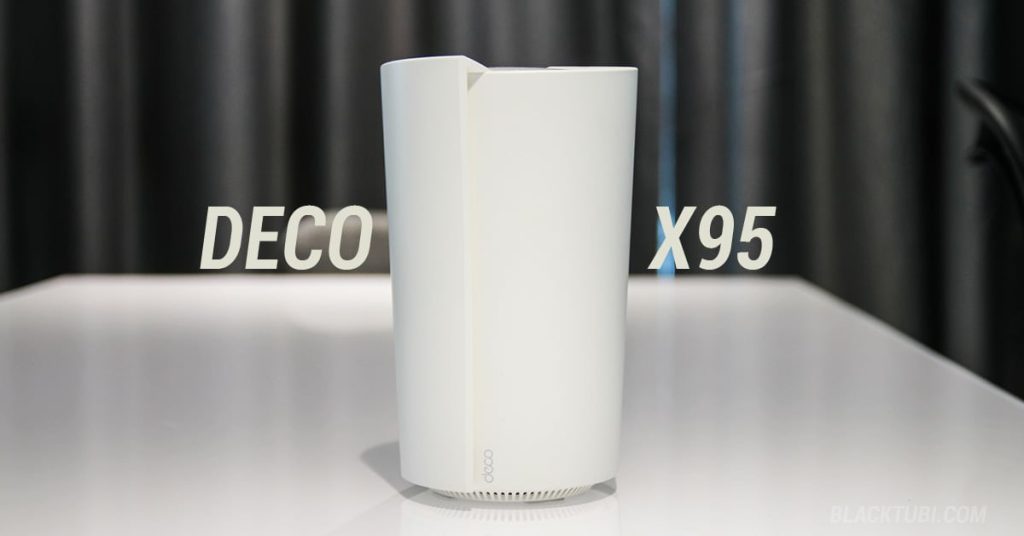
If you ever used a mesh Wi-Fi system, you know they are great at eliminating Wi-Fi dead zone and improving Wi-Fi coverage. But, what if you need a faster speed while having strong coverage at the same time? Well, TP-Link’s latest flagship Deco X95 might be an answer for that.
The brand new Deco X95 retails at RM1899, a slight bump over the Deco X90 it replaces. It’s a minor refresh with specifications improvement. The MUJI-esque design is still here and I always liked how it looks. The Deco X95 can blend into most interior design easily with the simple and clean design.
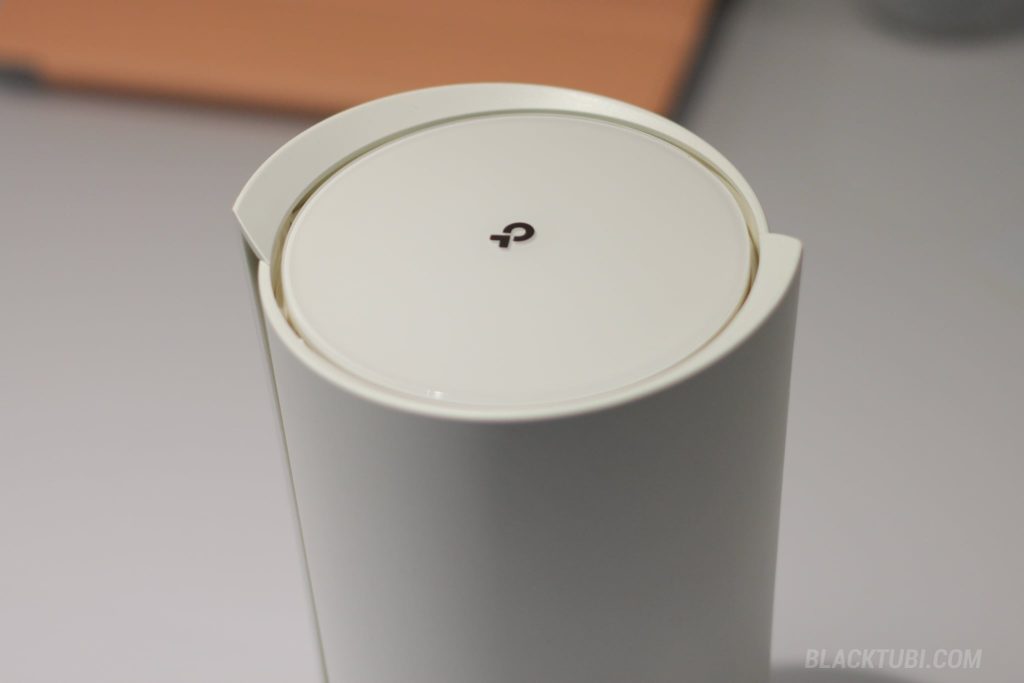
The Deco X95 feels like a more polished product. The Wi-Fi network is faster, the mesh roaming feels more seamless and it just feels much more responsive than the Deco X90. That’s probably due to the upgraded Wi-Fi specification and the use of a much faster processor on the Deco X95.
Specs and Hardware
The biggest change is probably the Wi-Fi 6 radio. The Deco X95 comes with Wi-Fi 6 AX7800 capability, making it 20% faster than the predecessor. TP-Link also upgraded the procesor of the product to the newer Braodcom 1.7GHz Quad-Core SoC which is around 10% faster than the Deco X90.
| 2.4GHz | Wi-Fi 6 up to 574 Mbps (2×2 40Mhz) |
| 5GHz-1 | Wi-Fi 6 up to 2402Mbps (2×2 160Mhz) |
| 5GHz-2 | Wi-Fi 6 up to 4804Mbps (4×4 160Mhz) |
| CPU | Broadcom BCM6756 1.7Ghz Quad-Core CPU |
| RAM | 512MB DDR3L RAM |
| Ports | 1x 2.5G WAN/LAN + 2x Gigabit WAN/LAN |
The Deco X95 retained a tri-band setup with dual 5GHz network. This will provide more Wi-Fi backhaul capacity since TP-Link has upgraded to use multiband mesh backhaul instead of just one dedicated backhaul. Most mesh Wi-Fi systems in the market are just dual-band and they are rather slow.
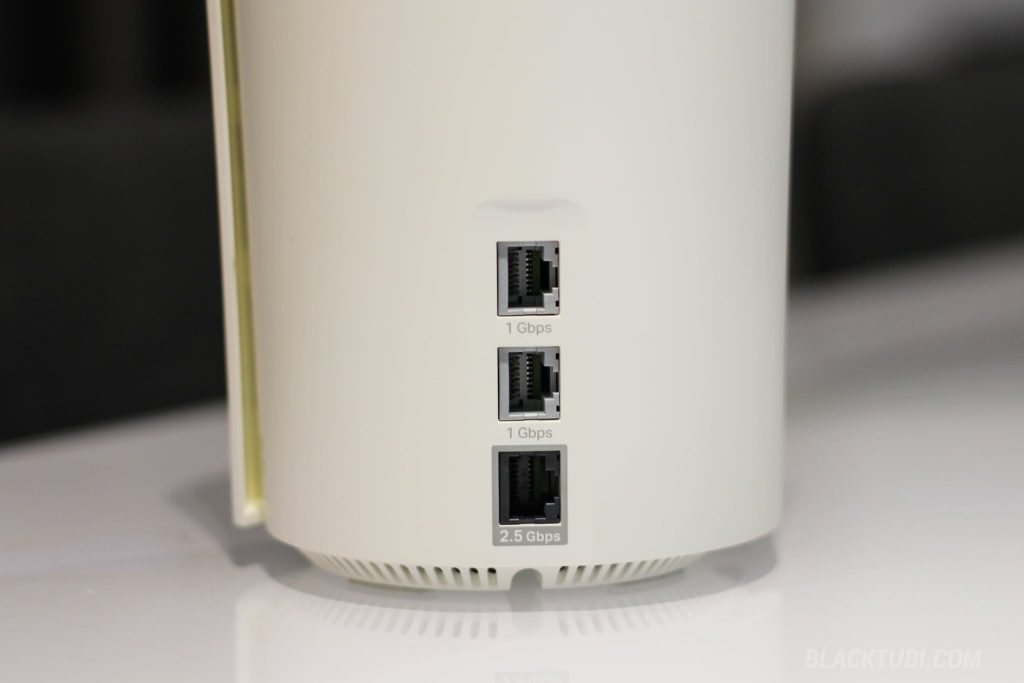
The biggest external change is probably the network ports. There’s a single 2.5G Ethernet WAN/LAN port and 2x Gigabit Ethernet LAN ports. That’s a total of 3 Ethernet LAN ports on each unit of Deco X95 instead of just 2 Ethernet LAN ports on the Deco X90.
Deco X95 Wi-Fi Performance
Let’s jump right into the Wi-Fi performance test where it matters the most. On the short distance test, the Deco X95 can deliver Wi-Fi speed over 900Mbps easily. Not a surprise here as most Wi-Fi 6 routers should be able to do this at short distance without any obstruction.
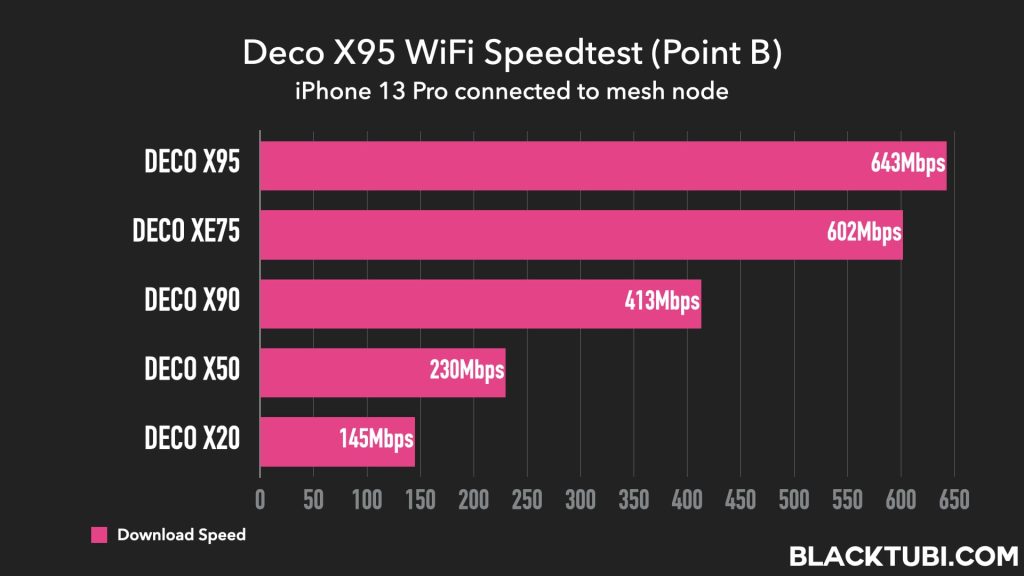
The mesh node performance is a rather significant step up from the predecessor. When running speed test on my Wi-Fi 6 supported laptop, the Deco X95 is around 10% faster. I also notice the speed is more consistent with speedtest consistently reaching the same speed on multiple attempts.
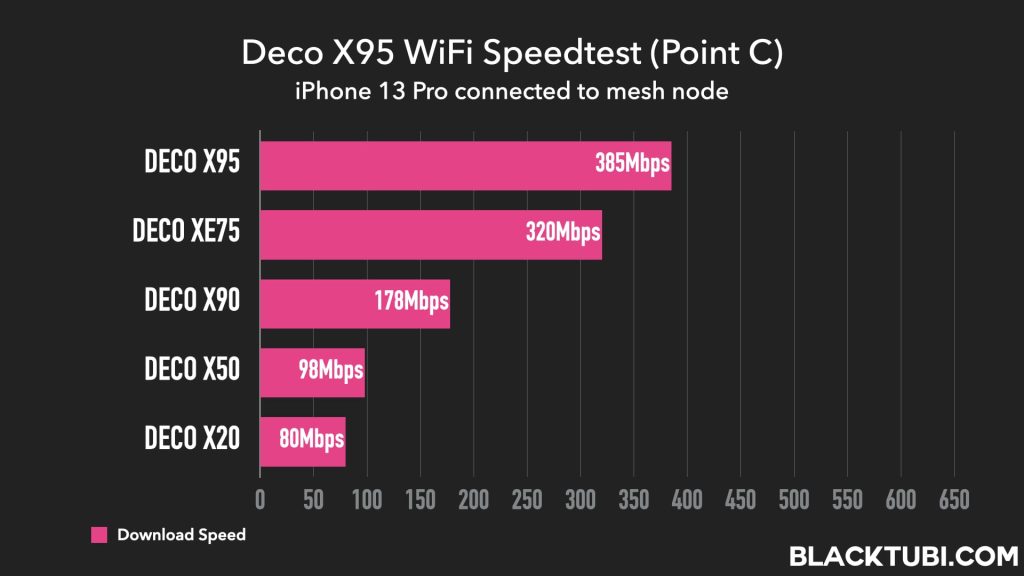
There’s a minor improvement on Wi-Fi coverage as well. When testing at a similar spot, the signal strength of the Deco X95 is close to 10% stronger than the Deco X90. That’s probably due to the use of Broadcom’s newer BCM6715 5GHz Wi-Fi 6 radio chipset with improvements on Wi-Fi interference mitigation.
But, speedtest don’t tell the full story when it comes to overall network quality. The Deco X95 loaded latency is much lower than other cheaper mesh Wi-Fi systems. This is very noticeable when scrubbing videos or quickly scrolling contents on TikTok. There’s almost zero lag when scrolling videos on TikTok. This also resulted in lower latency when playing games over the Wi-Fi network as well.
Deco AI-Driven Mesh
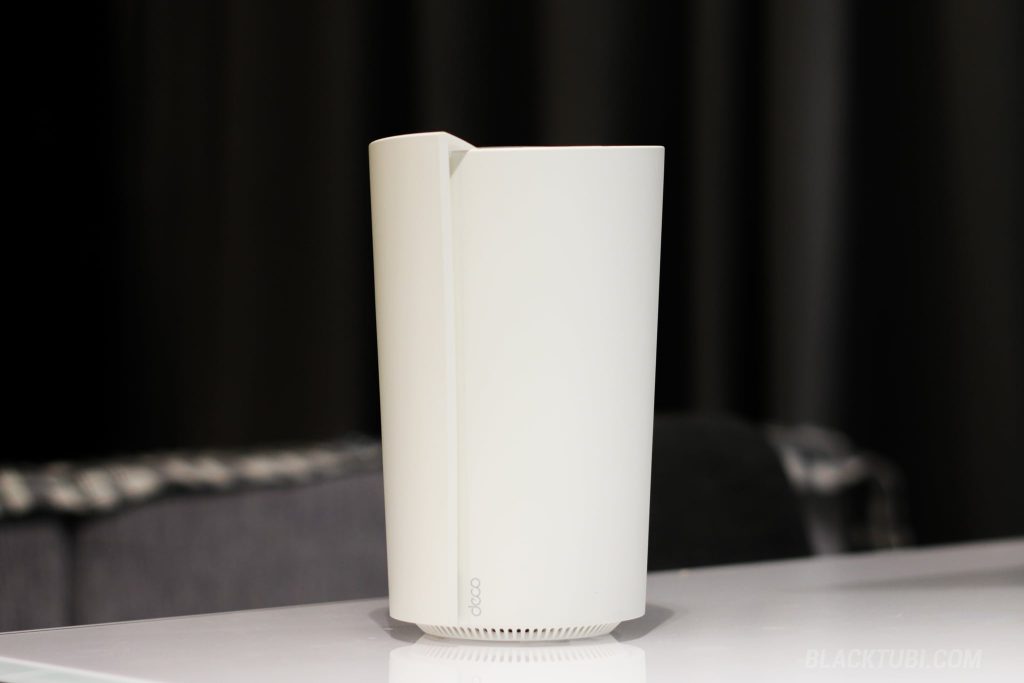
My favorite will be TP-Link’s AI-Driven Mesh technology which is what TP-Link calls their mesh backhaul management and roaming technology. As I walk around in my house, network switching is always instanteneous, fairly close to the experience of an enterprise grade wireless access point system.
Deco is really good at making sure my devices are always connected to the most optimal mesh node. That’s really important for a mesh Wi-Fi as there are many mesh nodes at home.
Firmware and Features
TP-Link’s latest Deco app is better than before. It’s already one of the best in the market and it’s even better now. The updated Deco app is more polished and offers a more refined user-experience. It’s probably one of the best designed mesh Wi-Fi app in the market now.
The app will show all connected Wi-Fi devices and their current utilized network speed. It’s also possible to block suspicious devices or restrict their network usage timing from the Deco app. TP-Link Deco app is also cloud connected which means it works even when I am in another country.
The star of the show is TP-Link’s amazing HomeShield parental control feature. You can choose selected devices and prevent them from accesing web contents based on selected categories. It is a great feature if you have young children at home and you wish to prevent them from abusing the Wi-Fi network.
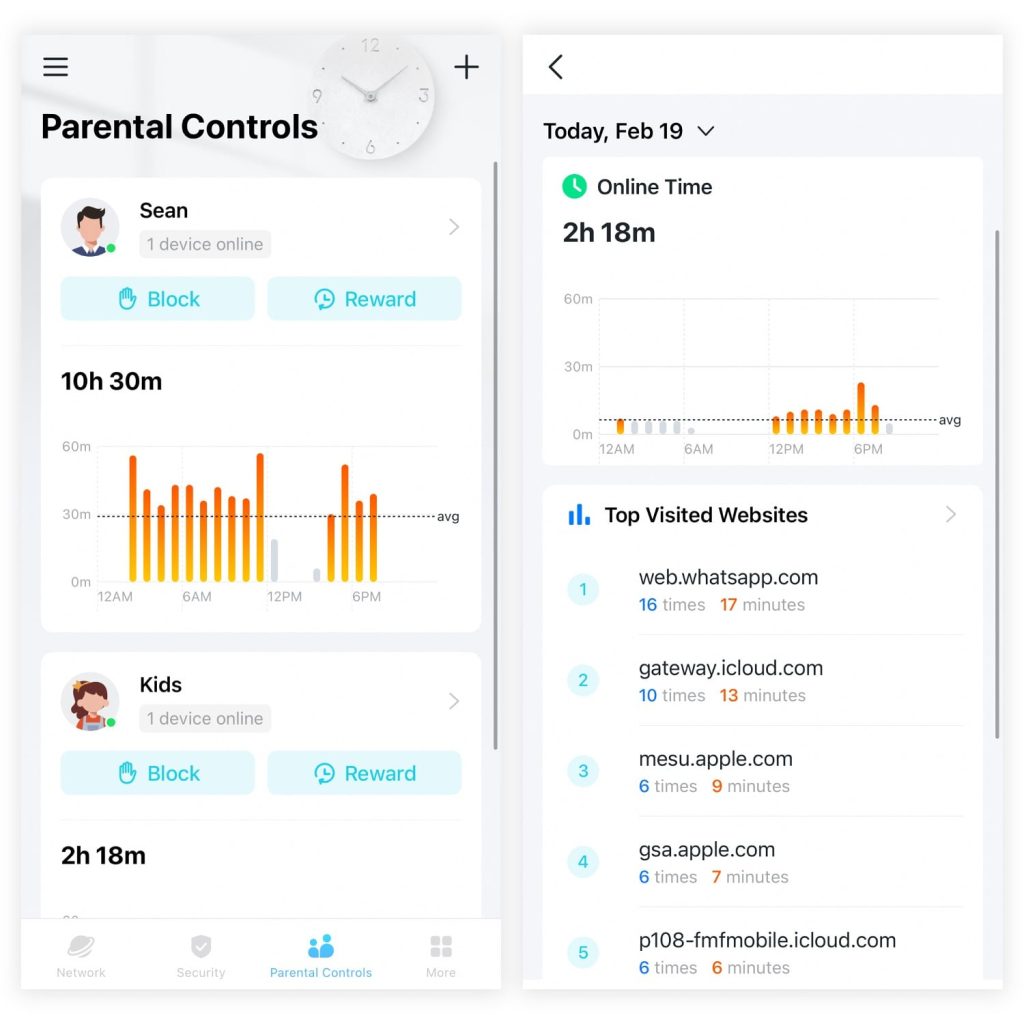
I also really liked how the Deco app presented all the information in a user-friendly and digestible way. The Deco app will report the hourly network usage trend and their top visited webpages. It allowed me to monitor my younger family members and ensure they are not using the Internet on bedtime.
But, while the HomeShield basic features are free. The advanced reporting function and granular controls do require HomeShield Pro subscription which costs RM26.90 per month. That’s something to consider about if you wish to utilize all these advanced features in the Deco system.
Another part of HomeShield is the enterprise grade firewall designed to block harmful and scam pages. I tested it with several known webpages and it will block them from being accessed. But, just bear in mind this feature relied on a known database so it might not block some of the new malicious website.
Closing Thoughts
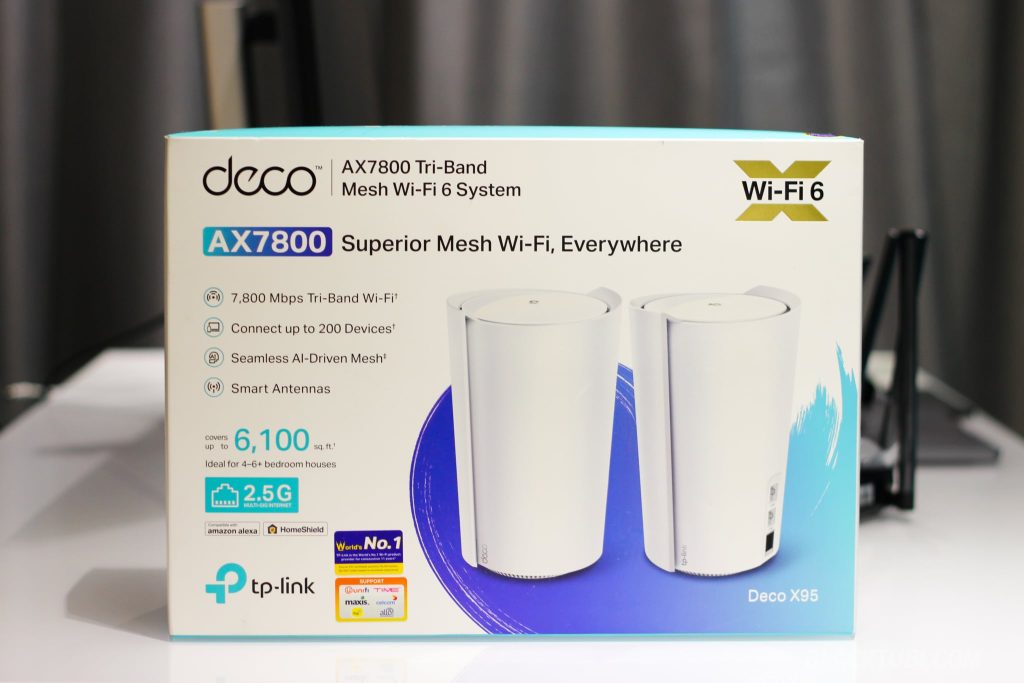
TP-Link Deco X95 is the fastest Deco mesh Wi-Fi system TP-Link ever made. The specs bump provided a much appreciated performance boost and that resulted in a stronger coverage as well. I also liked the new Deco app that’s more polished with a more refined user-experience.
At RM1899, the Deco X95 is a well-rounded premium mesh Wi-Fi systems. It’s capable of delivering a fast, responsive Wi-Fi network with strong coverage. The premium pricetag is justified by the much faster Wi-Fi speed and significantly lower latency on the mesh nodes than a cheaper mesh Wi-Fi system.
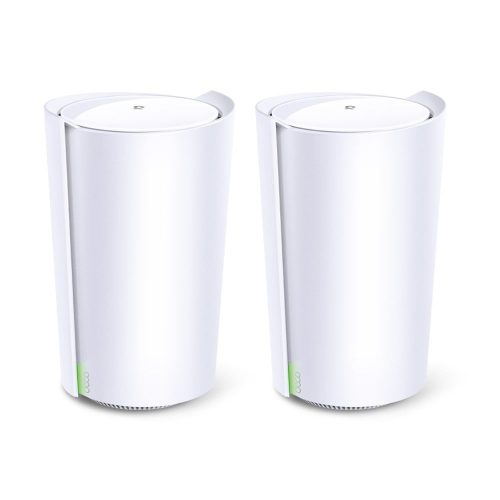
TP-Link Deco X95
9.3
Tubi Rating
pros
- 3 Gigabit LAN/WAN on each unit
- Faster speed and slightly stronger coverage than the previous flagship Deco
- Robust performance and great stability
cons
- Some HomeShield features require Pro subscription

I have the Deco X20 as a router, but its processor usage reaches 80%, causing Wi-Fi interruptions due to many connected devices (around 60). We are considering buying the Deco X95 as the main router and using four Deco X20 units as access points. Would this be helpful?
Yes, the Deco X95 will be a huge upgrade from the Deco X20.
Hi, firstly thanks for such an awesome website and reviews and feedback, hoping you can help advise between a standalone router or a mesh network for a 2 story, 4 bed uk home, on a 1gb fibre connection. Currently have the isp router a vodafone thg3000 which loses alot of speed over wifi range, due to the location of entry in the lounge for the fibre it isnt easy or cheap to install ethernet, hence want ideally at least 500mb for the house wifi and can use ethernet in the lounge for 1gb when needed, im stuck between choosing a… Read more »
You will definitely need the Deco X95 and it will deliver 500Mbps for most part of your home easily. I will retire the Unifi AC Lite once you got the Deco X95 installed.
Hi, I went ahead and ordered the Deco X95, and glad I did, I get 785 wireless in the main bedroom above the living room where the base deco x95 is, 300 wireless in daughters room, furthest point away from the two deco units, and 555 to 600 in the study. I have the PC and laptop connected by ethernet to the wireless Deco on 2nd floor and get 630, if I move the Deco unit away from the wall onto the landing, it goes up to 730, so fine to move it if downloading a really large file. Only… Read more »
That’s certainly a huge upgrade over your existing solution! Yup, you can play around with the positioning of each units and it might help to improve the performance slightly. Consider enabling the fast roaming feature to improve the overall seamless roaming feature as well.
Hi, can this Deco X95 Support Unifi 2GBps internet connection?
Yes it can support 2Gbps Internet connection but it will be hard to obtain anywhere close to 2Gbps over the WiFi connection.
COMPARE TO ASUS XT8 IS THIS WAY BETTER?
They are more or less the same, performance wise as the ASUS ZenWiFi XT8 received a silent spec bump.
Hi, can I use x95 as main router and pair it with 2 m9+? Would it work?
Thanks
No it wouldn’t work. One unit of Deco need to be connected via wire.
It would.100% work, all Decos can be mixed seamleasly. It Just might not be too much faster than than the all M9 setup.
Hi sifu. Thinking to replace all the three units of M9 plus with X95. Currently using AP mode with erthenet backhaul. Just upgrades to unifi 800mbps. Is it advisable to do so?
Yes, the Deco is X95 is much faster. I suggest using the Deco X95 as the main router bypassing your exisiting router for an even better performance.
if use X95 as main router and then pairing up with another 2 XE75 via ethernet backhaul for 800mbps, is it ok?
Sounds good but I am not really sure how the 6GHz band gonna work as the Deco X95 does not support 6GHz
Purchase 2packs TP Link Deco X60 after reading ur Deco X60 review.
It doesn’t really work well on 2nd node satellite wireless connection for master bedroom wifi connection . It manage to get 50mbps speed over (500mbps) from 1st main node .
TPLink CS inform to chg of 2nd deco frm main deco . Speed not improve at all.
May I know how to improve the wifi setting
Try to change your placement. Do not place the second unit on the signal dead zone, second unit should be placed at somewhere with somewhat decent signal to the main unit and rely on the extended signal to reach the intended dead-zone. Think of the concept like a repeater.
I’m planning to upgrade my deco m9 for my unifi 500mbps ( soon 800mbps). Living in a 2 story semiD. Thinking of either xe75 or the x95. Only my samsung s23U has wifi 6e, others only wifi 6. Pls advice tq
If you can afford it, get the highest end model will definitely provide better performance. Perhaps the Deco BE85 for future proof since TM will be giving free 800Mbps upgrade soon.
Haha. I also wish to get wifi 7 straight. But price is an issue.. that’s why considering either x95 or XE75. Was wondering if use the xe75 WiFi 6e as a backhaul, with the main node at the ground floor and the satellite directly one floor above, would it be too far? Tqvm
Then distance is fine as long as it’s not more than 2 walls.
Hi. I’m currently on 500mbps plan and using 2 units of Deco X50, one located in the living room first floor and another in the bedroom second floor. My setup is the default wireless backhaul, which gives me around 450mbps reading from the main deco, but I only get an average speed of 200mbps from the satellite node.
Should I get X95 (one or two units) for me to get a min speed of 400mbps in the bedroom? Thx.
Yes, the Deco X95 should give you at least 400Mbps in the bedroom. What you are getting from Deco X50 is more or less expected and close to my test result too.
Hi Blacktubi. May i know how to setup wired backhaul or wireless backhaul?
It uses wireless backhaul by default, if you wish to use wired backhaul, just connect them with LAN cable and it will switch automatically.
Hi, I want to know that with your set up, what speed are you able to get if you are connecting wired to PC/Laptop on 2nd unit while both unit is on Wireless Backhaul Connectivity. From your review Wi-Fi speed is ok but I want to know that is it still able to achieve upwards of 800+Mbps as I would like to set up 1 unit in LR and another in my room with Lan connection to my PC/Laptop. I believe you’re current only 1Gbps package as well am I right?
Yup, I am using the 1Gbps plan. If your placement is optimal, you should be getting around 700Mbps with a wired connection to the mesh node.
Is there anyways to maximise the full speed without destroying my budget? A single high end wifi 6/7 router/mesh with a good wifi receiver or just this set up will be good enough? Budget around 2K.
This product should be good enough and able to attain at least 500Mbps most of the time.
Hi Blacktubi, I have purchased it and currently using it but sadly with my current set up, I’m only able to achieve around 300-500 Mbps only but average test was only able to reach around 300++. Is there anyways to increase the speed itself? Will by getting a third unit and place in between both have any possibilities to increase it?
Perhaps you can try to adjust the placement to obtain better performance. Try to ensure they are not more than 2 walls apart.
Testing it at a temporary house at this moment as will be moving soon but currently there is only 1 Wall but there are few Furnitures like TV, Sofa’s and Bedframe in the way. New house may have less furniture obstructions, but the angle seems to be around 2-3 Walls thou. So not really sure will it be the same or better or worst so I’m thinking of possibilities of getting the 3rd to maybe offset it. What your thoughts?
I reckon to just stick to it unless it starts to impact your day to day operation. Speed is always just a number and not an actual indication of actual usage scenario. It gets really complicated these days .
Maybe, wire both mesh nodes together?
Like you Jayson, I’m facing the same issue and I’m planning to wire them together.